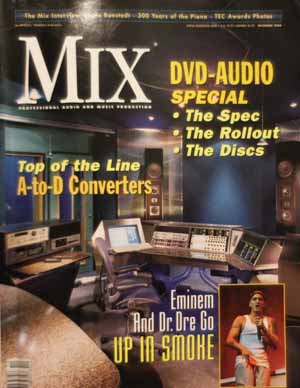Hundreds of articles have been written about the fall of the music industry, but there’s a story I tell clients when the conversation turns to it. I finally went back and researched the two articles I talk about. This is Part Two.
In the five years that passed since the 1995 article I referenced in Part One, the recording industry was hell bent and singularly focused on establishing a new, higher quality format for music that would replace the CD and maintain the traditional album configuration.
 In December of 2000, Mix Magazine dedicated an entire issue to this new format; DVD-Audio (A). The DVD-A standard was 5.1 (five speakers and a subwoofer) with 24 bit resolution (the existing CD used 16 bit audio and two speakers).
In December of 2000, Mix Magazine dedicated an entire issue to this new format; DVD-Audio (A). The DVD-A standard was 5.1 (five speakers and a subwoofer) with 24 bit resolution (the existing CD used 16 bit audio and two speakers).
I reference one of the several articles in this issue (Paul Verna, “DVD-Audio Arrives!”, Mix, December 2000, pp. 37-44.). “DVD-Audio is finally ready for prime time; the Warner Music Group released its initial batch of DVD-A discs on November 7, 2000. Those releases – on the Warner Bros., Atlantic, Elektra, Teldec and Erato labels- carry a suggested list price of $24.95, packaged in jewel boxes and clearly labeled as DVD-Audio titles. More Warner releases, including titles on the Nonesuch, Giant and Rhino catalog imprint are set for a December 2000 and January 2001 release. DVD-A players (prices range) from the low hundreds of dollars to $1,200 and up. Most of the DVD-Audio players in the US incorporate the encryption technology mandated by the recording industry (RIAA) and some include a watermarking chip that is designed to protect music copyrights.”
As consumers, we were mostly unaware of some extremely important issues that either led up to, or paralleled the announcement.
- For four years, the music industry had been locked in a serious battle with the movie industry concerning this format. After all, films were already produced in Dolby 5.1. It was basically equal in quality. But, from a patent standpoint it didn’t financially benefit the music companies.
- Sadly, over time, the product the music industry had begun marketing wasn’t music. Music was just the advertising jingle for their real product which was the delivery medium. Every time a new format was introduced, the industry banked on significant revenue as consumers upgraded their existing music catalogs. Since we owned Frampton Comes Alive on vinyl, we would buy it on Cassette, CD and then again on DVD-A.
- Not surprisingly, the DVD-A announcement was DOA. In February of 2001 ( TWO MONTHS AFTER THIS MIX ARTICLE), the file sharing site Napster experienced it’s peak historical usage with over 25 million users and 80 million songs shared.
By July of 2001, the RIAA got the courts to shut down Napster, but the iceberg had already gouged the ship from bow to stern. It turns out that consumers didn’t care about improved quality OR owning media. The music industry lost site of the real product…music. Incredibly, the industry at that time had no plan to take advantage of downloading technology. Despite what is now obvious, they literally didn’t see it coming. Their resultant solution was to bring legal action against consumers and providers of illegal downloads. And make no mistake, this was illegal. As a result, iTunes is now the largest record label in the world with estimated 2013 revenues of 13 billion dollars. No wonder the recording industry has been so reluctant to release their catalogs!
Of the eight record labels mentioned in the article, only four still exist. Ironically, an enitre industry whose business model was based on the fact that their consumers could hear… didn’t listen.

[…] Part Two, we’ll jump forward five years to December of […]